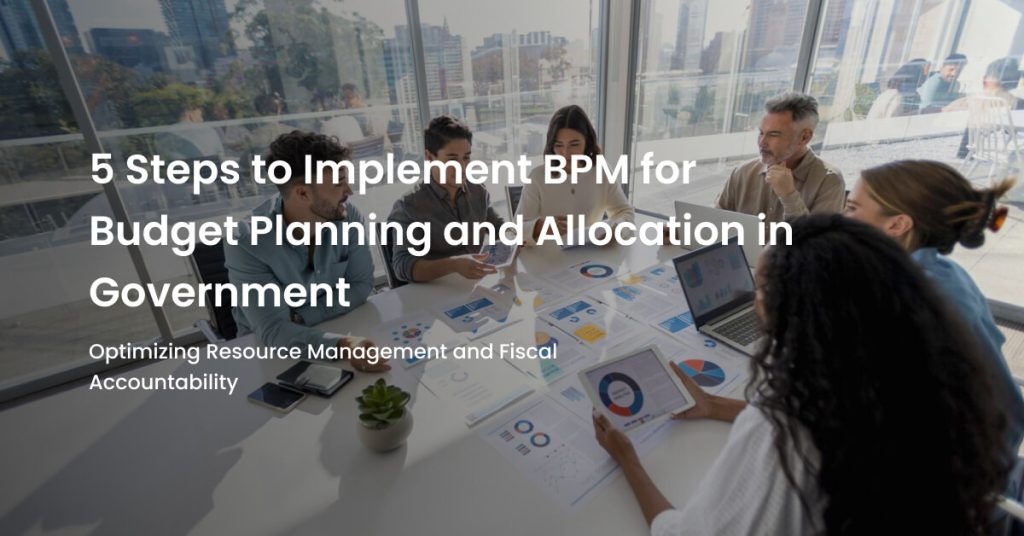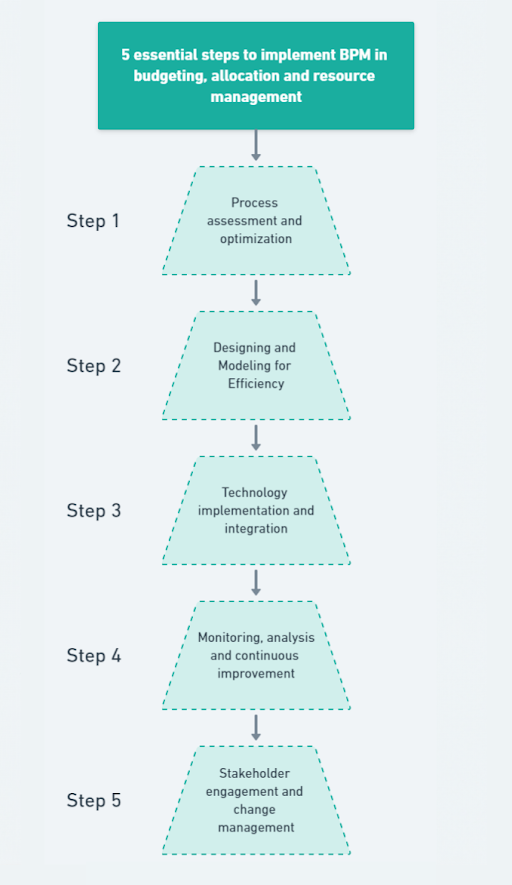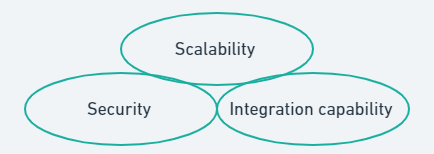
Introduction
Budget planning and resource management for government initiatives require meticulous planning, collaboration, control, and monitoring of financial operations. Governments across the globe are seeking innovative means to optimize financial performance, eliminate bottlenecks, and streamline operations. One solution that has been proven, especially in planning and resource management, is Business Process Management (BPM).
This blog highlights five essential steps to implement BPM for budget planning and resource management and addresses the edge BPM solutions offer in revolutionizing legacy approaches to fiscal management.

5 Essential Steps to Implement BPM in Budgeting, Allocation, and Resource Management

Step 1: Process Assessment and Optimization
As the first step towards implementing business process management (BPM) in the public sector for budget planning and resource allocation, it is essential to identify, assess, and streamline existing budgetary processes. As a foundational step, this is crucial for discerning:
- The current state of budget management
- Practices and operations
- Identifying areas for improvement through BPM tools
By effectively assessing the existing budget/resource allocation processes, governments can leverage BPM tools to create frameworks that include efficient, transparent, and accountable mechanisms to manage public funds. It also helps in identifying inefficiencies, redundancies, and bottlenecks, which helps to avoid wasting resources, delaying projects, and decreasing fiscal accountability.
Methodologies to Identify Bottlenecks:
- Process Mapping: Utilizing BPM tools like Oracle BPM to generate a detailed visual map of current budgeting and resource utilization processes helps in identifying the flow of operations and decision-making paths to pinpoint existing bottlenecks.
- Data Analysis: By leveraging BPM consulting services and BPM tools like Microsoft Power Automate, analyze performance data and metrics related to budgeting processes. This paves the way to identify patterns of delays, cost overruns, and resource bottlenecks. This procedure provides a comprehensive view of the existing budget performance.
- Stakeholder Insights: Another way to detect inefficiencies in budget processes is to gather information straight from stakeholders. Their insights and observations reflect the bottlenecks they experience firsthand, which is invaluable in terms of understanding the nuances of budgetary processes.
- Benchmarking: Compare current processes to the best practices in other sectors or similar institutions to identify gaps in efficiency and effectiveness.
After this effective assessment, prioritize specific processes that need to be optimized to ensure that the implementation of BPM is focused and strategically aligned with the intended goals.
Step 2: Designing and Modeling for Efficiency:
After an effective evaluation of current budget processes, the next step is to redesign and model more efficient, transparent processes that address the inefficiencies effectively. This phase is pivotal as it converts insights collected from the assessment into actionable improvements for redesigning budget processes with the assistance of business process management tools.
Next, leverage a business process automation platform to design and model budget processes. BPM tools here provide a comprehensive framework that aids in proposed improvements. It comes in handy for:
- Visualize processes to track areas of optimization.
- Standardize procedures across stages of budget processes to ensure consistency.
- Automate workflows to streamline repetitive, mundane tasks that reduce manual errors and accelerate the overall budgeting process.
Let’s look at some benefits of using BPM tools for redesigning budget processes
Criteria | Strategic Advantage |
|---|---|
Collaborative environment | A business process automation platform facilitates a shared environment where stakeholders can actively contribute, collaborate, and review the budget process in the design phase. This enhances communication and aligns with institutional budgeting goals. |
Simulation tools and predictive outcomes | With complete BPM solutions, process designers can use BPM’s simulation features to test their processes in a virtual setting, guessing how they will affect things, how well they will work, and how they will use resources. This aids in the refinement and improvement of budget processes. |
Regulatory compliance | With effective documentation and traceability, BPM tools support design processes to comply with regulations and ensure standardization. |
Step 3: Technology Implementation and Integration
Moving on to the most significant step in the process: implementing the redesigned model using the right BPM solutions for budget management and resource allocations.
Integrating solutions for the public sector and government services requires meticulous consideration of a multitude of factors. The selection criteria should effectively consider the following:
- Security
- Scalability
- Integration capability

Given the sensitive nature of the government’s financial data, the BPM solution should strongly offer security features, including data encryption, access control and other relevant security measures. While leveraging BPM services, institutions should also ensure that the solution is capable of handling an extensive amount of data that is optimal in performance and scales without compromising efficiency. Additionally, the BPM used for implementation should have robust integration capabilities, enabling seamless connectivity with existing records, resources, and Enterprise Resource Planning (ERP) systems.
After these considerations, implement and customize the redesigned model of budget management and resource allocation within the BPM framework. Before full-scale deployment, test the budget processes in virtual environments and ensure the existing bottlenecks are strategically handled in the new model.
Finally, provide comprehensive training for all users, budget managers, financial officers, and concerned staff, to adeptly utilize the BPM system for future budget planning, iterations, troubleshooting, and other tasks. Establish dedicated BPM services as a support team to address issues promptly and ensure smooth operations along the journey.
Step 4: Monitoring, Analysis, and Continuous Improvement
Implementing BPM for government budgeting and allocation needs constant optimization through monitoring, analysis, and iterations. By measuring the effectiveness of the new model, institutions can indulge in constant improvement strategies to enhance budget processes and resource management. Key performance indicators (KPIs) specific to budget management, like budget variance, cost efficiency, cycle time, and fund utilization, provide valuable insight into budget processes, enabling targeted interventions.
BPM tools, with its real-time visibility and analytical capabilities, can be a crucial addition to the process of optimization. Here’s what it offers:
- A customizable dashboard with real-time data on key metrics and performance.
- Alert capabilities to notify when indicators fall outside acceptable ranges, enabling quick responses to potential issues.
- Functionality to generate reports for in-depth analysis of budget trends, variance, and performance.
Step 5: Stakeholder Engagement and Change Management
The final step is to navigate change management in BPM implementation. To adopt BPM in the process of budget processes and resource allocation is not only to have technological adoption but also to embrace cultural and procedural changes.
To have a smooth transition, ensure:
- Early involvement of stakeholders.
- Clear communication throughout the process.
- Customized training for users.
Finally, navigating resistance, valuing feedback, and embracing change have a long-term impact on BPM implementation, resulting in improved efficiency and fiscal accountability in budget processes.
Squareone Technologies’ Robust Process Automation Services:
SquareOne Technologies is one of the leading process automation services in the GCC region, empowering institutions to streamline, optimize, and automate their business processes. By reducing time and effort, maximizing efficiency, and enabling effective tracking to enhance overall operations, SquareOne Technologies is driving transformative changes and innovations. Leveraging SquareOne’s expertise in business process management solutions, institutions can embrace digital transformation and remain at the forefront of industry advancements. Adopt BPM solutions to optimize your processes today with SquareOne Technologies.
The Final Word
The application of BPM in budget handling and resource management can help government institutions optimize budgeting processes, reduce fiscal waste, and make operations more efficient and accurate. BPM solutions, with its capabilities, play a crucial role in strategic budgeting processes, leading to significant improvements in financial performance. Whether you’re considering a BPM solution or planning to switch, SquareOne Technologies offers comprehensive solutions for process automation.
If you’d like to explore SquareOne Technologies’ solutions, click here!
















